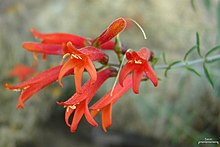
Choisya is a small genus of aromatic evergreen shrubs in the rue family, Rutaceae. Members of the genus are commonly known as Mexican orange due to the similarity of their flowers with those of the closely related orange, both in shape and scent. They are native to southern North America, from Arizona, New Mexico, Texas and south through most of Mexico. In its generic name Humboldt and Bonpland honoured Swiss botanist Jacques Denis Choisy (1799–1859).

Keckiella is a genus of plants in the plantain family. It includes several species of plants known commonly as keckiellas. A few species may be called beardtongues or penstemons because some keckiellas once belonged to genus Penstemon. Keckiellas are native to the American southwest, especially California. They bloom in attractive snapdragon-like flowers. Genus Keckiella was named after the American botanist David D. Keck.
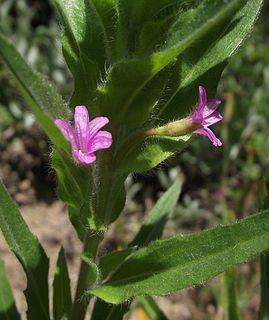
Epilobium densiflorum is a species of willowherb known by the common names denseflower willowherb, dense spike-primrose or dense boisduvalia. It is native to western North America from British Columbia to Baja California, where it is found in a variety of habitats. This is an erect annual often exceeding a meter in height with fuzzy green foliage. The pointed leaves are up to 8 centimeters long near the base of the plant, and the upper leaves are generally more hairy than the lower. The stem may branch or not. The top of the stem is occupied by a hairy, leafy, densely flowered inflorescence. Each flower has four deeply notched petals in shades of pinkish purple to nearly white with dark veining, each about a centimeter long. The fruit is a cylindrical capsule about a centimeter long.
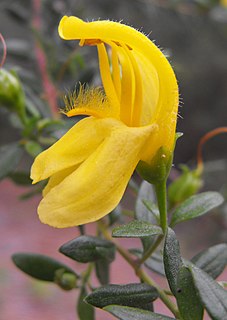
Keckiella antirrhinoides is a species of flowering shrub in the plantain family known by the common names snapdragon penstemon and chaparral beardtongue.
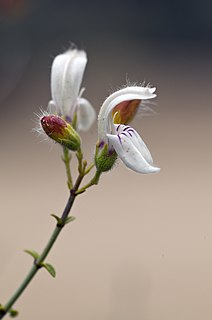
Keckiella breviflora is a species of flowering shrub in the plantain family known by the common name bush beardtongue.

Keckiella cordifolia is a species of flowering shrub in the plantain family known by the common name heartleaf keckiella. It is native to the coast and coastal mountains of southern California and northern Baja California, and it is a resident of chaparral and coastal woodland plant communities.

Keckiella corymbosa is a species of flowering shrub in the plantain family known by the common names redwood keckiella, red beardtongue, and red shrubby penstemon.
Keckiella lemmonii is a species of flowering plant in the plantain family known by the common name Lemmon's keckiella.

Keckiella rothrockii is a species of flowering plant in the plantain family known by the common name Rothrock's keckiella. It is native to the desert mountains of southeastern California and adjacent Nevada, where it lives in sagebrush and woodland. This is a short, wide shrub reaching maximum heights near half a meter. The hairy green stems bear small oval-shaped leaves up to 1.5 centimeters long. The flowers vary in color from brownish to yellow to cream, and are sometimes striped with dull purple or brown. Each is up to about 2 centimeters long with curling lobes at the mouth. Inside the tubular flower are stamens, including a flat, sterile stamen known as a staminode.

Chaenactis artemisiifolia, with the common name white pincushion, is a species of flowering plant in the daisy family. It is native to the coastal Peninsular Ranges of Southern California and Baja California, in the chaparral and woodlands.

Arctostaphylos refugioensis is a species of manzanita, known by the common name Refugio manzanita. It is endemic to Santa Barbara County, California, where it can be found along the immediate coastline, including the vicinity of Refugio State Beach, and into the Santa Ynez Mountains of the northwestern Transverse Ranges.

Calochortus obispoensis is a rare California species of flowering plants in the lily family known by the common name San Luis mariposa lily. It is endemic to San Luis Obispo County, California, where it grows in the chaparral of the coastal mountains, generally on serpentine soils.

Lithospermum californicum is a species of flowering plant in the borage family known by the common name California stoneseed. It is native to southern Oregon and northern California, where it can be found in many types of mountain habitat, such as forest, woodland, and chaparral. It is a hairy perennial herb growing from a taproot and woody caudex. It produces a clump of branching, spreading stems up to about 40 centimeters long. The stems are lined with widely lance-shaped, lightly hairy leaves up to 5 centimeters long. The flowers appear near the ends of the stem branches, each with a calyx of narrow, pointed sepals. The corolla is bright golden yellow and nearly a centimeter wide at the mouth.
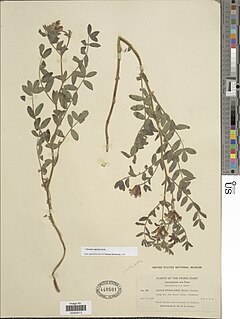
Hosackia stipularis, synonym Lotus stipularis, is a species of legume endemic to California. It is known by the common name balsam bird's-foot trefoil. It is found in most of the northern and central coastal and inland mountain ranges and foothills. It can be found in many types of habitat, including forest, chaparral, and disturbed areas. This is a mostly erect perennial herb with a leafy, often hairy and glandular form. Its slender branches are lined with leaves each made of several leaflets up to 2 centimeters long. The leaves sometimes have prominent stipules. The inflorescence is a compact array of up to 9 pink flowers. Each flower is elongated, the corolla borne in a tubular calyx of sepals, and the entire unit may exceed a centimeter long. The fruit is a legume pod 2 or 3 centimeters long containing several beanlike seeds.

Phacelia californica is a species of phacelia known by the common names California phacelia and California scorpionweed. It is native to coastal northern California and Oregon, where it grows in chaparral, woodland, and coastal bluffs and grassland.
Solanum dimidiatum is a species of plant in the family Solanaceae known by the common names western horsenettle, Torrey's nightshade, and robust horsenettle. It is native to the central United States, where it grows in many types of habitat, including disturbed areas. In California it is known as an introduced species and a noxious weed. It is a rhizomatous perennial herb producing an erect stem up to 80 centimeters tall. It is covered in yellow prickles and branched hairs. The leaves may be up to 15 centimeters long, their edges wavy to lobed and sometimes toothed. The inflorescence is a branching array of several flowers. Each flower has a bell-shaped corolla measuring 3 to 5 centimeters wide. It is lavender to purple, or white. The five large, yellow anthers are about a centimeter long. The fruit is a spherical yellow berry up to 3 centimeters wide.
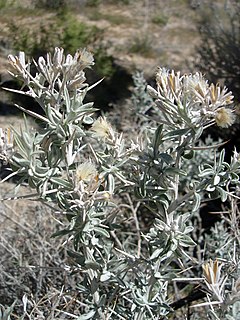
Tetradymia stenolepis is a species of flowering plant in the aster family known by the common name Mojave cottonthorn. It is native to the deserts around the intersection of Arizona, Nevada, and eastern California, where it grows in woodland and scrub habitat on sandy and gravelly substrates. It is a bushy shrub with many branches coated in woolly white fibers and growing to a maximum height just over a meter. The narrow leaves are 2 or 3 centimeters long and harden into straight, sharp spines. Clusters of woolly leaves grow near the spines. The inflorescence bears up to 7 flower heads which are each enveloped in four or five woolly phyllaries. Each head contains up to four or five tubular yellow flowers each around a centimeter long. The fruit is a hairy achene which may be nearly 2 centimeters long, including its pappus of long bristles.
Tetradymia tetrameres is a species of flowering plant in the aster family known by the common name fourpart horsebrush and dune horsebrush. It is native to the Great Basin, where it occurs in western Nevada and just over the border in Mono County, California. It is a plant of dry scrub and sand dunes. It is a bushy, woolly shrub with many erect, spineless branches. It is the largest of the horsebrushes, growing up to two meters in height. The soft, woolly leaves are narrow and threadlike, growing up to 4 centimeters long. Shorter leaves occur in clusters around the primary leaves. The inflorescence bears 4 to 6 flower heads which are each enveloped in four or five woolly phyllaries. Each head contains up to four or five light yellow flowers each around a centimeter long. The fruit is a hairy achene which may be up to a centimeter long, including its pappus of long bristles.

Velezia rigida is a species of flowering plant in the family Caryophyllaceae. It is native to southern Europe. It is also present in northern California where it is an introduced species. It is an annual herb growing from a taproot and producing a hairy, glandular, branching green or purplish stem up to 40 centimeters tall. The linear leaves are up to 2 centimeters long. Solitary flowers occur in the leaf axils. Each flower has a very long, cylindrical, ribbed calyx of fused sepals forming the tubular throat of the flower, measuring at least a centimeter in length. At the top of the tube is the flower corolla which has five pink or purplish petals.

Toxicoscordion paniculatum is a species of flowering plant known by the common names foothill deathcamas, panicled death-camas, and sand-corn. It is widely distributed across much of the western United States, especially in the mountains and deserts of the Great Basin region west of the Rocky Mountains. It grows in many types of habitat, including sagebrush plateau, grasslands, forests, and woodlands, etc.
